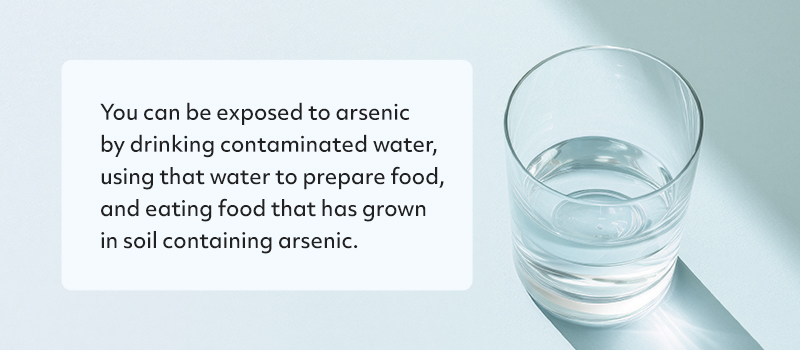The Top 3 Dangerous Metals and Metalloids That May Be Lurking in Your Water
Nov 9th 2023
Many contaminants can be found in a household's drinking water, including some heavy metals and metalloids. Lead and mercury are some of the most plentiful heavy metals in drinking water, while arsenic is one of the most commonly found metalloids. Industrial, medical, and agricultural sectors have led to the runoff of many toxic heavy metals and pesticides into our soil, raising concerns about their impact on our health and the environment.
View Our Drinking Water Systems
The Environmental Protection Agency (EPA) requires all community water systems to prepare and deliver an annual water quality report to their customers each year. In these reports, you can learn more about the quality of your water and the regulated contaminant found. It will also detail your provider's actions to restore safe drinking water.
By understanding that these three contaminants can be found in your drinking water and identifying their sources, you can take steps to reduce your exposure.
What Is Lead and Why Is It in Water?
Lead is a naturally occurring chemical element. Tough yet easy to bend and work with, it became the chosen metal for water pipes years ago before we knew about its health risks. Lead can quickly enter our drinking water when plumbing materials start to corrode, especially water with low mineral content and high acidity. The EPA estimates that drinking water can make up 20% of a person's total exposure to lead.
Typical sources of lead in drinking water include pipes, fixtures, and faucets older than 20 years. It can also be found in some leaded-brass parts in older submersible pumps used in private wells. Today, the Safe Drinking Water Act (SDWA) prohibits a certain amount of lead content from being used in pipes, plumbing fittings, and fixtures.
How to Detect Lead in Your Water
You cannot see, taste, or smell lead in drinking water. You can learn the quality of the water leaving the municipality in your annual Consumer Confidence Report (CCR) as well as test your water at home. Your water provider can also determine if you have a lead service line providing water to your home, and some programs may assist in removing it. Note that any work, such as replacement, could increase your exposure to lead for up to six months after completion.
Many public water systems and laboratories that are certified to test for lead in water will also test your drinking water upon request.
Side Effects of Lead in Your Water
There is no safe level of lead for the body, and even low exposure levels can be harmful — especially in children, infants, and pregnant mothers. Risks can vary depending on the person, the chemical conditions of the water, and the amount consumed. Common side effects of lead in drinking water include:
- Damage to the brain and kidneys
- Interference with the production of red blood cells
- Behavior and learning problems in children
- Cardiovascular effects and increased blood pressure
- Risk of hypertension
- Reproductive issues in men and women
View Our Drinking Water Systems
What Is Arsenic and Why Is It in Water?
Arsenic is highly toxic and has been found in groundwater in the United States. It naturally enters lakes, rivers, and underground water when rocks containing arsenic erode and dissolve. Industrial and agricultural waste products can also discharge arsenic into our groundwater, as it is used in many insecticides and herbicides.

You can be exposed to arsenic by drinking contaminated water, using that water to prepare food, and eating food that has grown in soil containing arsenic. Those who smoke tobacco can also be exposed to arsenic since tobacco plants take up soil containing it.
How to Detect Arsenic in Your Water
You can detect arsenic by taking a water sample from the tap you drink from. For most households, you should test your kitchen sink's water. Those with private wells should test their water supply throughout the year to detect arsenic.
Side Effects of Arsenic in Your Water
Immediate side effects of exposure to arsenic include vomiting, abdominal pain, and diarrhea. Typically, these symptoms are followed by numbness and tingling in the arms and legs and muscle cramping. Long-term health effects include:
- Diabetes
- Increased risk of cancers in the bladder, lungs, and liver
- Cardiovascular and respiratory disease
- Skin problems like discoloration and lesions
- Developmental effects
The health impacts of arsenic can take many years to develop. Pregnant people are especially at risk, with adverse pregnancy outcomes and infant mortality due to increased chances of cancer, lung disease, and heart problems.
View Our Drinking Water Systems
What Is Mercury and Why Is It in Water?
Mercury is a metal that occurs naturally in the environment. Commonly used in thermometers and fluorescent light bulbs, mercury exposure is hazardous. Just a tiny amount can produce enough fumes to contaminate the surrounding air, while skin contact can cause it to be absorbed into the bloodstream, leading to health problems.
Mercury can get into your drinking water from rain and snow carrying it from the air into water supplies like rivers, lakes, and reservoirs. It can also seep into underground water supplies from industrial waste sites. Consuming large quantities of contaminated fish can also increase your mercury exposure.
How to Detect Mercury in Your Water
You'll need the appropriate EPA-approved test method to detect mercury in your water. A professional testing process can also include compiling information about your water supply source, local geology, and surrounding land use. You can also have mercury contamination measured by sending a sample of your water to a laboratory outfitted with the proper analysis equipment.
Side Effects of Mercury in Your Water
People exposed to high levels of mercury, even in a short period, can experience adverse side effects. Mercury can have toxic effects on your nervous, digestive, and immune systems while causing lung and kidney issues. Consuming mercury can also lead to neurological and behavioral conditions like:
- Tremors
- Insomnia
- Neuromuscular effects
- Headaches
- Memory loss
- Cognitive and motor dysfunction
Kidney effects from mercury exposure can range from increased protein in urine to kidney failure.
Reduce Contaminated Water in Your Home With Multipure
Metalloids and heavy metals can contaminate our water and pose several risks to human health and our environment. While many people believe that boiling drinking water removes these substances, doing so actually leads to water evaporation, which can increase the concentration of chemicals.
Testing your water is expensive, and while it can detect contaminants at that specific moment in time, the quality of your drinking water can change from one day to the next. The safest method is having a filtration system that treats these dangerous chemicals.
Multipure's NSF-certified filters can reduce contaminants like lead and mercury through chemisorption, and the Multipure Aqualuxe and Aquaperform are certified to reduce Arsenic V. In addition to treating these contaminants, Multipure's systems are certified to reduce microplastics, forever chemicals, and dozens of other contaminants that can be found in drinking water.
Browse our products or contact us to learn more about how our water filtration systems can reduce contaminated water in the home for better health and wellness.


